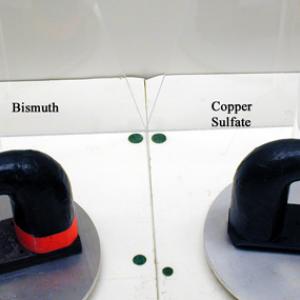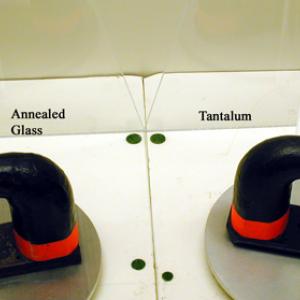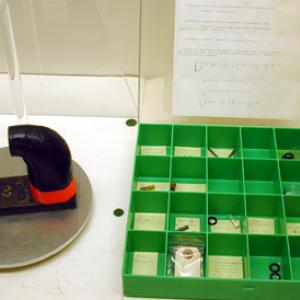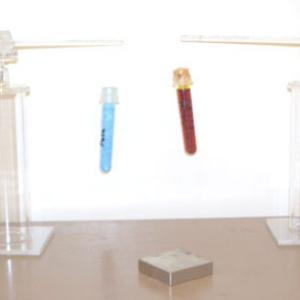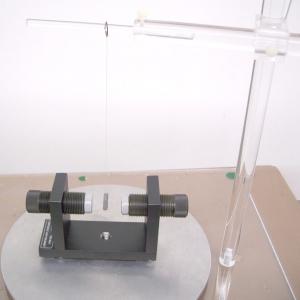College of Liberal Arts & Sciences
5G30.10 - Paramagnetic, Diamagnetic, & Ferromagnetic Demos
Place the magnets carefully in the middle of the rotating supports. Suspend the samples between the poles of the magnet or a little higher. Wait for the sample to come to its preferred orientation in the magnetic field ( 2 to 3 minutes). Slowly turn the rotating support and observe that the sample will follow along so that it can maintain its orientation. Samples are as follows: Tantalum (Para); Titanium (Para); Copper Sulfate (Para); Ferric Chloride (Para); Bismuth (Dia); Glass (Dia); Bismuth Nitrate (Dia); Nickel (Ferro); Copper (Ferro). The copper will show Para magnetism but this is due to induced eddy currents. Copper has virtually no magnetic moment or susceptibility.
The slides of the liquid oxygen are in the Electrically and Magnetism Slide Notebook in room 58. You may also make liquid oxygen by following the procedure in 5G30.20.
A simpler version of this demo is to place some paramagnetic and diamagnetic samples in test tubes and hang them from a rotating arm. Bring the big neodymium magnet near one of the samples on the arm and it will either be attracted or repelled depending on the sample.
The smaller but more powerful neodymium horseshoe adjustable magnets may work better for this demonstration.
- John A. Daffron, A Para- and Dia-Magnetism Balance", TPT, Vol. 47, # 6, Sept. 2009, p. 395.
- Charles A. Sawicki, "Inexpensive Demonstration of the Magnetic Properties of Matter", TPT, Vol. 36, # 9, p. 553, Dec. 1998.
- Henry H. Kolm, "Why Are So Few Substances Ferromagnetic?", TPT, Vol. 20, # 3, Mar. 1982, p. 183-185.
- Gary E. Young, Kyle Allen, Charlie Swartz, H. Richard Crane, "How Does an Electron Create Magnetism?", TPT, Vol. 18, # 6, Sept. 1980, p. 478.
- "Hydrogen Diamagnetism", TPT, Vol. 17, # 2, Feb. 1979, p. 101.
- Daniel Laumann, "Is an Apple Magnetic: Magnetic Response of Everyday Materials Supporting Views About the Nature of Science", TPT, Vol. 55, #3, March 2017, p. 142-145.
- David P. Jackson, "Dancing Paperclips and the Geometric Influence on Magnetization: A Surprising Result", AJP, Vol. 74, # 4, April 2006, p. 272.
- S. P. Puri, "Diamagnetic Cylindrical Bar in a Field", AJP, 33, # 6, June 1965, p. 472.
- C. S. Schneider and John P. Ertel, "Experiments on Magnetic Materials", AJP, Vol. 46, # 8, Aug. 1978, p. 820.
- Es-3,4: Freier and Anderson, A Demonstration Handbook for Physics.
- E-102: Richard Manliffe Sutton, Demonstration Experiments in Physics.
- 32- 2: H. F. Meiners, Physics Demonstration Experiments, Vol. II.
- George M. Hopkins, "Dynamic Electricity", Experimental Science, p. 464.
- Vicki Cobb and Kathy Darling, "Tape Escape", Bet You Can!, p. 40.
- Simon Quellen Field, "More About Magnets", Gonzo Gizmos, p. 11 - 14.
- Arthur B. Ellis, Margret J. Geselbracht, Brian J. Johnson, George C. Lisensky, William R. Robinson, "Electrons in Solids", Teaching General Chemistry - A Materials Science Companion, p. 28.
- 6.20: Jearl Walker, "Bubbles Moved by Magnetic Field", The Flying Circus of Physics with Answers.
- "Paging Mr. Post: Let's Do Another Study", Uncle John's 'Unstoppable' Bathroom Reader, p. 209.
- Joseph Frick, "# 337 - Experiments on Diamagnetism", Physical Technics: Or Practical Instructions for Making Experiments in Physics and the Construction of Physical Apparatus with the Most Limmited Means, p. 400.
Disclaimer: These demonstrations are provided only for illustrative use by persons affiliated with The University of Iowa and only under the direction of a trained instructor or physicist. The University of Iowa is not responsible for demonstrations performed by those using their own equipment or who choose to use this reference material for their own purpose. The demonstrations included here are within the public domain and can be found in materials contained in libraries, bookstores, and through electronic sources. Performing all or any portion of any of these demonstrations, with or without revisions not depicted here entails inherent risks. These risks include, without limitation, bodily injury (and possibly death), including risks to health that may be temporary or permanent and that may exacerbate a pre-existing medical condition; and property loss or damage. Anyone performing any part of these demonstrations, even with revisions, knowingly and voluntarily assumes all risks associated with them.
